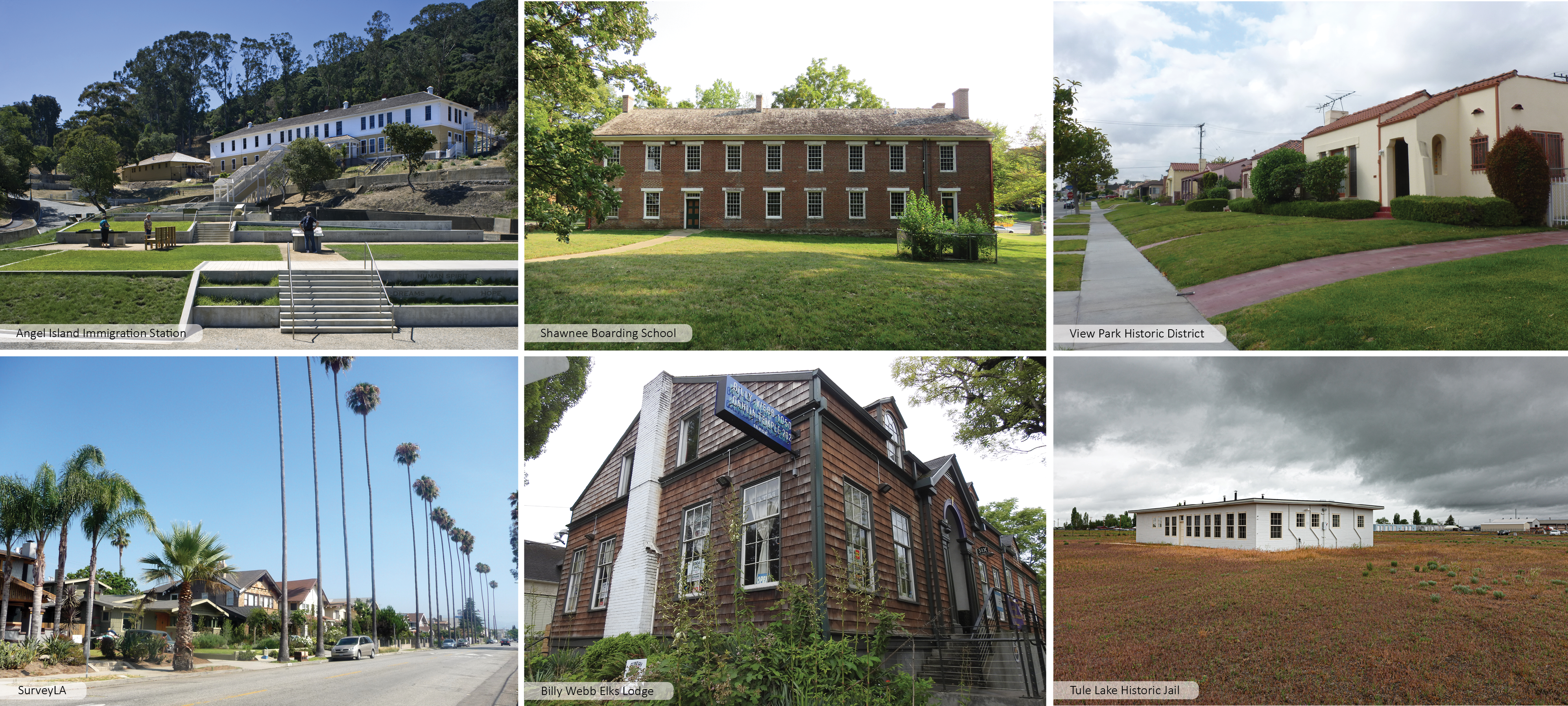Preserving Places and Stories of Marginalized Groups

ARG is committed to working with historically marginalized groups to recognize, preserve, and interpret the places that tell their rich histories, which have often been neglected in the historic preservation field. These groups include women, immigrants, LGTBQ+ individuals, Native Americans, Asian Americans, Native Hawaiians, Pacific Islanders, Black Americans, and Latino/Latina Americans. ARG has extensive experience collaborating with community members to research and document their histories, secure historical designations, conduct historical resource surveys, and develop interpretive materials. We have also had the opportunity to plan for the rehabilitation or restoration of numerous sites that tell complex and dynamic stories of our nation’s past. We are proud to be a part of honoring the achievements of marginalized individuals and communities and preserving the history of how their lived experiences have shaped our country. Following are a few significant buildings and stories ARG has had the opportunity to help preserve.

Local, State, and National Register Nominations
African American Resources in California
Statewide, CA
ARG is working with the California Office of Historic Preservation (OHP) and the MPDF Advisory Group to develop a Multiple Property Documentation Form (MPDF) to document the complex history of African Americans in California and to provide a framework for the nomination of properties significant for their association with African American heritage.
African American Resources in Portland
Portland, OR
ARG worked with the City of Portland to develop a MPDF that focuses on honoring and documenting historically significant experiences of African Americans in Portland. This MPDF created the foundation for a series of National Register nominations to which ARG has subsequently contributed (in collaboration with Kim Moreland).
Portland, OR
A former African American YWCA building in Portland and the present-day home to a local African American fraternal order. It is the oldest community gathering space for African American social, political, educational, and civil rights groups since 1926. ARG nominated the building to the National Register of Historic Places (in collaboration with Kim Moreland).
(Listed on the National Register in 2020)
Dean’s Beauty Salon and Barber Shop
Portland, OR
The oldest continually operating Black-owned barber shop and salon in Portland. ARG nominated the building to the National Register of Historic Places (in collaboration with Kim Moreland).
(Listed on the National Register in 2022)
Portland, OR
Commissioned for construction by Dr. John D. Marshall, one of very few Black doctors practicing in Portland in 1952. The building served as a medical clinic for Black Portlanders, including Black Panther Party members, who were underserved by the city’s white-dominated medical systems. ARG nominated the building to the National Register of Historic Places (in collaboration with Kim Moreland).
(Listed on the National Register in 2023)
Portland, OR
A hub for early twentieth-century Black business and the only major hotel in Portland to welcome African American guests between 1906 and 1930. ARG nominated the building to the National Register of Historic Places (in collaboration with Kim Moreland).
(Listed on the National Register in 2022)
Portland, OR
The childhood residence of influential Kaw/Muscogee Creek jazz musician and composer, Jim Pepper. ARG nominated the building to the National Register of Historic Places (in collaboration with Kim Moreland).
(Listed on the National Register in 2023)
Portland, OR
The oldest extant worship space in Northeast Portland associated with one of Portland’s early Black congregations. ARG nominated the building to the National Register of Historic Places (in collaboration with Kim Moreland).
(Listed on the National Register in 2022)
Los Angeles, CA
The approximately 450-acre View Park development possesses significance in Black Ethnic Heritage and Southern California history. ARG nominated the building to the National Register of Historic Places.
(Listed on the National Register in 2016)
Los Angeles, CA
The Woman’s Building was a feminist art collective and place of refuge for lesbian and feminist artists and activists during the 1970s and ‘80s. ARG nominated the building to the National Register of Historic Places.

Historic Research, Assessments, Documentation, and Planning Services
Fresno Chinatown and Germantown
Fresno, CA
ARG prepared a historic context statement for Fresno’s “Chinatown” and conducted a historic survey of properties within the area. By the early 20th century, this area of Fresno was an ethnic mix with nine distinct groups living together: Mexican, African-American, Basque, Armenian, Chinese, Japanese, Italian, Portuguese and Germans from Russia.
Los Angeles, CA
The Kim Sing Theatre was a neighborhood theatre popular among the Chinese American community for its imported films. ARG was retained to prepare its Historic Resources Assessment (HRA).
Los Angeles Historical Housing and Land Use Study
Los Angeles, CA
ARG and our team are in the process of preparing a study that explores how the patterns of housing and land use policies that have historically perpetuated racial and socioeconomic disparities in the City of Los Angeles. The study will inform the City’s 2021-2029 Housing Element Update as well as future planning efforts.
San Francisco Chinese American Context Statement
San Francisco, CA
ARG peer-reviewed the Historic Context Statement (HCS), which documents the rich history and legacy of the Chinese American community in San Francisco from the mid-nineteenth century to the present.
SurveyLA, Los Angeles Asian American Historic Context Statement
Los Angeles, CA
Stemming from the City of Los Angeles city-wide survey, the Asian American Historic Context Statement focused on properties significant to the immigrant Asian diaspora. ARG led a consultant team through the MPDF and narrative contexts for the project.

Historic Structure Reports and Cultural Landscape Reports
200 Rhode St “Takahashi Trading Co”
San Francisco, CA
ARG nominated the building as a San Francisco Landmark, developed a Historic Structure Report, and completed exterior repair. Located within the South of Market (SoMa) district, 200 Rhode Island is significant for its association with the postwar resettlement of the Japanese community, particularly its long-term property owners, Henri Takahashi (1914-2002) and Tomoye Takahashi (1915-2016), and Martha Suzuki (1921-2012), who were prominent entrepreneurs and philanthropists.
Marysville, CA
The Bok Kai Temple has been a continuous religious and social anchor for the city’s Chinese population. ARG completed a Historic Structure Report, which included treatment recommendations for temple’s preservation and restoration.
Founder’s Church of Religious Science
Los Angeles, CA
Founder’s Church is a 1959 reinforced-concrete building was designed by preeminent African American architect Paul Revere Williams. Today, it continues its original use as church. Our work has included nominating the mid-century modern building for inclusion on the National Register for Historic Places, a Historic Structure Report, and development of a roadmap for future preservation and maintenance of the church.
Shawnee Indian Manual Labor Boarding School
Fairway, KS
Established in 1839 by the Methodist Mission Society in conjunction with the U.S. Bureau of Indian Affairs, the school systematically enculturated children from Shawnee, Delaware, Kaw, and other Indigenous nations in Euro-American social and religious traditions. Working with the Shawnee Tribe Cultural and Historical Preservation Committee, ARG performed a comprehensive conditions assessment and prepared a Historic Structures Report of the three remaining brick buildings with the goal of informing future maintenance and use of the site for the Shawnee Tribe.

Preservation, Restoration, and Rehabilitation
Angel Island Immigration Station
San Francisco Bay, CA
A National Historic Landmark, Angel Island served as a point of entry for thousands of immigrants at the turn of last century. ARG served as historical architect for the Station’s rehabilitation and conservation, including interpretive planning of the Detention Barracks and conservation of poetry etched on the walls.
Los Angeles, CA
Located in West Hollywood, the Factory was historically an influential gay club, acting for many as a social haven during the 1960’s and 70’s in Los Angeles. ARG provided historic preservation and architectural services.
Los Angeles, CA
ARG is providing historic architecture design and consultation services for the repair and reuse of the French Market building. The building has been identified as historically significant for its association with important events in the LGBTQ history of West Hollywood.
Riverside, CA
At a time when Asian immigrants were prevented from owning property, the Harada house represents those willing to challenge the law. ARG prepared a rehabilitation plan for the house with phased treatment recommendations.
Sacramento, CA
The Locke Boarding House is located within the National Historic Landmark District of the town of Locke, which was built by and for Chinese immigrants at a time of social and racial tension. After preparing an HSR for the building, ARG restored the boarding house for combined use as an interpretive site within the California State Park system and as office and gathering space for The Locke Foundation, a local community group.
San Francisco, CA
The first woman’s athletic club in the western United States, the building was incorporated in 1915 and is listed on the National Register Historic Places. ARG repaired the building’s historic windows.
Portland, OR
During WWII’s rise of hostility against Japanese, Yasui, a Japanese American, was held in this jail cell for 9 months as his trial went up to the U.S. Supreme Court. ARG created a plan to preserve and relocate the jail cell, which is now a centerpiece of the Japanese American Museum of Oregon’s exhibit space.
Tule Lake Segregation Center Historic Jail
Tule Lake National Monument, Newell, CA
The largest War Relocation Area for incarcerated Japanese Americans during World War II, Tule Lake Jail is a contributing structure to the Tule Lake National Historic Landmark. ARG led a team of engineers and conservators in the preparation of design documents and documentation prior to the exterior restoration and interior conservation of the historic structure, including wall graffiti by those incarcerated there.
